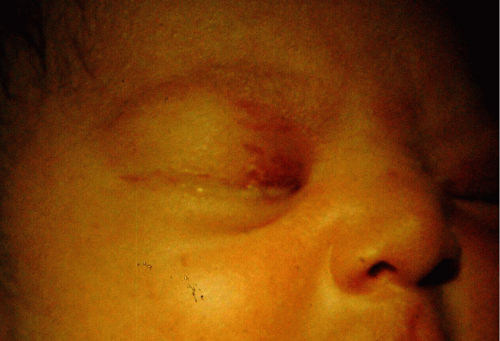Neonatal Conjunctivitis (Ophthalmia Neonatorum)
Jonathan C. Song
Neonatal conjunctivitis is defined as conjunctivitis presenting before 1 month of age (Fig. 1).1 Generally it can be divided into noninfectious and infectious categories. The most common noninfectious cause is a chemical conjunctivitis induced by silver nitrate solution used for prophylaxis against infectious conjunctivitis. Bacterial, chlamydial, and viral infections are major causes of infectious neonatal conjunctivitis; chlamydia is the most common.2,3 Other infectious agents that the infant may acquire as it passes through the birth canal during include, Streptococcus spp., Staphylococcus spp., Escherichia coli, Haemophilus spp., Neisseria gonorrhea, and herpes simplex.2 The time of onset of the conjunctivitis as well conjunctival scraping can aid in the diagnosis of the specific etiology of the neonatal conjunctivitis Table 1.
Table 1. | ||||||||||||||||||
|---|---|---|---|---|---|---|---|---|---|---|---|---|---|---|---|---|---|---|
|
LABORATORY TESTS
Laboratory studies for neonatal conjunctivitis are essential for proper management and diagnosis. Initial culture on chocolate agar or a Thayer-Martin test for N. gonorrhoeae should be obtained as well as blood agar for other bacteria. Chlamydial infection can be ruled out with a conjunctival scraping Giemsa stain for intracytoplasmic inclusion bodies or direct immunofluorescent antibody assay. In herpetic conjunctivitis, gram stain may reveal multinucleate giant cells or Papanicolaou smear may show eosinophilic intranuclear inclusions in epithelial cells. Culture for herpes simplex virus also can be indicated if a corneal epithelial defect is present or the diagnosis cannot be made on ocular examination alone with presence of vesicular lesions.4
MEDICAL MANAGEMENT
Topical 1% silver nitrate, 0.5% erythromycin, and 1% tetracycline are considered equally effective for prophylaxis of ocular gonorrhea and chlamydial ophthalmia in newborn infants.5,6 Recent studies indicate that 2.5% povidone-iodine solution also may be effective in preventing neonatal ophthalmia and appears to cause less chemical conjunctivitis as compared with either silver nitrate or erythromycin.7 Specific treatment for chemical conjunctivitis is not necessary, with spontaneous resolution in 2 to 3 days.
Stay updated, free articles. Join our Telegram channel

Full access? Get Clinical Tree



